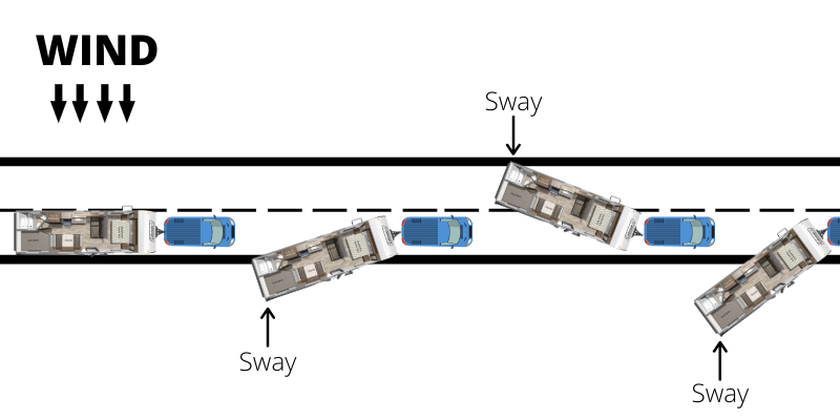Understanding the Causes of Trailer Sway and How to Avoid It
Posted by ProPride Hitch on 6th Jan 2022
When it comes to towing, safety should always be the top priority. ProPride Hitch is dedicated to providing a smooth and enjoyable experience on the road from start to finish. In order to get the most out of your towing experience, it's important to be familiar with the terminology and understand how to assess and correct any potential issues. To help you out, we've compiled a list of useful facts and definitions. After we go over these, we'll discuss the causes of trailer sway.
FACTS/DEFINITIONS

The 3P Hitch will be the last hitch you buy
The 3P Hitch is highly regarded as the best option on the market and is often referred to as the industry standard. Its advanced technology and commitment to research and development make it a standout product that significantly increases safety. The 3P Hitch eliminates sway, the need for corrective driving, and provides a smoother ride, making it unparalleled in the market. We are confident that it will be the last hitch you'll ever need to purchase.
Friction is your enemy
Friction can be a major issue when it comes to towing, but the 3P Hitch helps to eliminate it by stiffening the connection between the TV (towing vehicle) and the TT (trailer). This causes the combined mass and rotational inertia of the TV and TT to resist any forces that may cause the trailer to sway. It's important to be familiar with some key acronyms in the towing world: GCRW (maximum total load of a towed combination), GTWR (maximum allowable load of a loaded trailer, including the weight of the trailer itself and its fluids and cargo), and GVWR (maximum allowable total weight of a loaded vehicle or trailer, including the weight of the vehicle or trailer itself, passengers, fuel, and cargo).
Oscillating/Oscillation
Oscillation refers to a back-and-forth movement between two limits over time. The displacement of this movement is known as the amplitude. When two things are moving side-to-side or back-and-forth in this way, it becomes more likely that problems will arise.
Overhang
Overhang is the horizontal distance from the center of the rear axle of the tow vehicle to the back end of the vehicle.
Pivot Point
The pivot point is the point at which the trailer being towed pivots to create a tow angle. This is the point around which the trailer moves as it is being towed.
Pivot Point Projection ™
Pivot Point Projection is a term used to describe the way in which the 3P Hitch controls the trailer's effective pivot point. This term is specific to the 3P Hitch and more information about it can be found on the 3P Hitch page.
Tongue Weight
Tongue weight is the downward force exerted on the hitch ball by the trailer coupler. It's essentially the amount of weight or pressure being placed on the hitch ball.
Tow Angle
The tow angle is the angle created between the tow vehicle and trailer when the trailer moves away from the centerline of the combination. When the trailer is perfectly in line with the tow vehicle, the tow angle is zero degrees. A tow angle of zero to a maximum of 90 degrees allows the trailer to be turned around a corner as it is being towed.
Tow Rating
The tow rating is the allowable weight limit for a tow vehicle. It is calculated by subtracting the GVWR (gross vehicle weight rating) of the tow vehicle from the GCWR (gross combined weight rating)
Trailer Sway
Trailer sway occurs when the trailer being towed oscillates back and forth, creating multiple tow angles over a period of time. It is not the same as the tow angle created when turning a corner. Trailer sway is caused by the trailer continuing to oscillate away from the centerline of the tow combination at various amplitudes. It's important to understand the difference between these two concepts, as trailer sway can be dangerous and should be avoided.
Weight Distribution
Weight distribution refers to the way in which the load exerted on the hitch ball, or tongue weight, is distributed between the tow vehicle and trailer axles. This helps to ensure that the weight is balanced and the vehicle is being towed safely.
Wheelbase
The wheelbase is the horizontal distance between the center of the front axle and the center of the rear axle on the tow vehicle. It is an important measurement that helps to determine the stability of the vehicle and its ability to tow safely.
Yaw
Yaw refers to the side-to-side movement of the trailer on the hitch ball. It is a type of motion that can occur when the trailer is being towed and can affect the stability of the tow combination.
Causes of Trailer Sway

Towing Speed
The speed at which you choose to tow your trailer can have a significant impact on trailer sway. Tests have shown that speeds above 45 mph tend to cause almost any trailer to sway. However, with highway speeds often much higher than this, it may not be practical or even legal to tow at a speed that will effectively control trailer sway. It's important to consider this when deciding on a towing speed and take steps to ensure the stability of the tow combination.
High Winds
Winds blowing directly against the side of a towed trailer can push the trailer, causing it to pivot on the hitch ball and create a tow angle. The larger the surface area of the side of the trailer, the greater the force of the wind will be. Towing in high winds is generally not recommended, as it can be dangerous and should only be done with caution if necessary. It's important to be aware of wind conditions and take appropriate precautions when towing a trailer.
Gusting Winds
Winds can increase in velocity due to gusts caused by weather or when a high wind is blocked by a tree line or bridge overpass and then clears while you are towing. This can cause a sudden increase in the side force on the trailer, causing it to pivot on the hitch ball and create a tow angle. It's important to be aware of these potential gusts and take appropriate precautions when towing a trailer to ensure the stability of the tow combination.
Bow Waves
A bow wave is a wind produced by a large semi-truck, box truck, or van as it moves down the highway. This wind travels around the vehicle and down the sides, creating a disturbance in the adjacent lanes. This disturbance can cause a sudden change in air pressure on the side of the trailer, causing it to pivot on the hitch ball and create a tow angle. Some people describe the sensation of being caught in a bow wave as feeling like the entire tow combination is being pulled into the other lane. It's important to be aware of the potential for bow waves and take appropriate precautions when towing a trailer.
Bad Roads
When traveling across the country, you may encounter roads that are in need of repair, particularly in certain areas such as Michigan. These uneven, poorly maintained roads can cause a trailer to become unbalanced, causing it to pivot on the hitch ball and creating a tow angle. It's important to be aware of these road conditions and take appropriate precautions when towing a trailer to ensure the stability of the tow combination.
Downhill Towing
When towing a trailer downhill, it's possible for the trailer to roll faster than the tow vehicle. The tow vehicle is designed to slow down when the accelerator is released, but trailers don't have this feature. As a result, if the trailer is traveling at a higher speed than the tow vehicle, it can start to yaw or move side-to-side, which can affect the stability of the tow combination. It's important to be aware of this potential issue and take appropriate precautions when towing downhill.
Poor Trailer Design
Some trailers are simply better designed for towing than others, due to the various variables that go into trailer design. These variables must be taken into account in order to properly balance the trailer for towing. Even with a well-designed trailer, it can be difficult for the designer to determine the optimal layout, as trailers are used by a wide range of customers and for different purposes. This can further complicate the process of designing a trailer that tows well.
Improper Loading
The placement of the load or cargo in a trailer can have a significant impact on the weight and weight distribution of the trailer and the tow combination. Factors such as the black and gray water tanks, supplies, clothing, and other items carried in the trailer can all affect the overall weight and distribution of the trailer. It's important to consider these factors when loading a trailer in order to ensure a safe and stable towing experience.
Poor Weight Distribution Hitch Adjustment
A weight distribution hitch is designed to help distribute the weight of the trailer evenly between the tow vehicle and the trailer axles. If the hitch is not properly adjusted, it can cause the trailer to have either too much or too little tongue weight, which can contribute to trailer sway. It's important to properly adjust the weight distribution hitch in order to avoid sway and ensure a stable towing experience.
ProPride Hitch hopes that this article has provided valuable information that will help you to understand the terminology related to towing and how to eliminate sway. By understanding these concepts, you can make informed decisions about your towing setup and ensure a safe and stable experience on the road.


